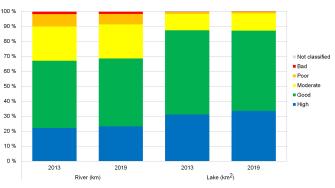Ecological state of inland waters mostly good

More than 82% of lakes in mainland Finland have good or high ecological status. This means that human activities have not significantly or permanently impaired the natural state of the water body. Altogether 18% of the lake area are in moderate, poor or bad condition.
The situation is less favorable for rivers. Of the total river length, 63% is in good or high ecological status, while 37% is in moderate, poor or bad state.
| River km | Lake km2 | |
| Not classified | 21 | 12 |
| Bad | 490 | 32 |
| Poor | 3,029 | 377 |
| Moderate | 9,897 | 4,635 |
| Good | 14,984 | 14,248 |
| High | 7,650 | 9,524 |
Rivers and lakes classified into different categories in mainland Finland in 2019. The data also include artificial and heavily modified waters, which have their own assessment criteria. Source: Finnish Environment Institute (Syke).
Eutrophication particularly affects small lakes
Eutrophication is particularly damaging to the ecological status of small and shallow lakes. This is evident through algal blooms, shoreline overgrowth, and water turbidity. Large open waters, especially the major lakes in Lapland, have largely been spared from eutrophication. Approximately one-third of Finland's lake surface area is regulated.
Rivers face a variety of problems. They have been dredged and straightened, diminishing their habitats. Changes in flow conditions and runoff from catchment areas cause siltation. Dams and other water structures prevent fish and other aquatic organisms from moving around in the river.
Development stagnates
The ecological state of Finland's inland waters has not improved in recent years. The trend has been positive mainly in individual lakes and rivers. The slow progress is mainly due to the fact that diffuse pollution from agriculture and forestry has remained high. It has also been difficult to correct the fundamental changes in streams caused by hydraulic engineering.

Speeding up improvements in water status
In Finland, new promising methods have been developed to mitigate eutrophication and restore river ecosystems. The implementation of these methods is being accelerated by the Water Protection Enhancement Program. The water management measures for different water bodies are defined in regional water management plans. The common goal of European Union member states is that all waters should be at least in good status by 2027, with no deterioration.
